Corn maize Study guides, Class notes & Summaries
Looking for the best study guides, study notes and summaries about Corn maize? On this page you'll find 114 study documents about Corn maize.
All 114 results
Sort by
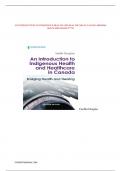 Popular
Popular
-
AN INTRODUCTION TO INDIGENOUS HEALTH AND HEALTHCARE IN CANADA BRIDGING HEALTH AND HEALING 2ND ED
- Exam (elaborations) • 142 pages • 2024
-
- $45.48
- 1x sold
- + learn more
AN INTRODUCTION TO INDIGENOUS HEALTH AND HEALTHCARE IN CANADA BRIDGING HEALTH AND HEALING 2 ND ED Vasiliki Douglas CONTENTS PART I INDIGENOUS CULTURE AND HEALTH 1. Introduction: First Nations, Métis and Inuit in Canada: Understanding the Issues 2. Western and Indigenous Ways of Knowing 3. Cultural Competency, Cultural Sensitivity and Cultural Safety 4. Historical Overview PART II INDIGENOUS HEALTH AND THE CANADIAN HEALTHCARE SYSTEM 5. Understanding the Determinants of Health and C...
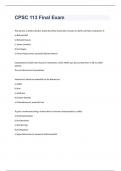
-
CPSC 113 Final Exam 2023 with correct answers
- Exam (elaborations) • 23 pages • 2023
-
- $12.99
- 1x sold
- + learn more
This person, a NASA scientist, stated that they found alien remains on Earth and they could prove it: a) Richard Doll b) Richard Hoover c) James Lovelock d) Carl Sagan e) Tyron Hayes b) Richard Hoover Cyanobacteria fossils were found in meteorites, which NASA says proves that there is life on other planets. True or False False Antarctica's blood red waterfall can be blamed on: a) Sulfer b) Iron c) Methane d) Carbon Dioxide e) Chloride b) Iron To give a nonhuma...
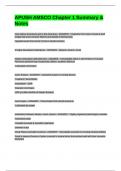
-
APUSH AMSCO Chapter 1 Summary & Notes
- Exam (elaborations) • 12 pages • 2024
-
Available in package deal
-
- $12.99
- + learn more
APUSH AMSCO Chapter 1 Summary & NotesAPUSH AMSCO Chapter 1 Summary & NotesAPUSH AMSCO Chapter 1 Summary & NotesAPUSH AMSCO Chapter 1 Summary & NotesAPUSH AMSCO Chapter 1 Summary & NotesAPUSH AMSCO Chapter 1 Summary & Notes How Native Americans got to the Americas - ANSWER - *migrants from Asia crossed a land bridge that once connect Siberia and Alaska in Bering Sea, migrated south from Arctic Circle to South America 3 highly developed civilizations - ANSWER - Mayans, Aztecs, Incas Mayan...
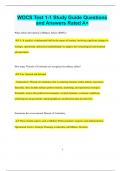
-
WOCS Test 1-1 Study Guide Questions and Answers Rated A+
- Exam (elaborations) • 55 pages • 2024
-
- $11.99
- + learn more
WOCS Test 1-1 Study Guide Questions and Answers Rated A+ What defines Revolution in Military Affairs (RMA)? A. It signifies a fundamental shift in the nature of warfare, involving significant changes in strategic, operational, and tactical methodologies to adapt to new technological and doctrinal advancements. How many Threads of Continuity are recognized in military affairs? Two Internal and External Explanation: Threads of Continuity refer to enduring elements within military...
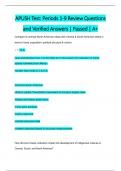
-
APUSH Test: Periods 1-9 Review Questions and Verified Answers | Passed | A+
- Exam (elaborations) • 191 pages • 2024
- Available in package deal
-
- $20.48
- + learn more
Compare & contrast North American tribes with Central & South American tribes in terms of area, population, political structure & culture : N.A. -less sophisticated than C & SA tribes bc of how slowly the cultivation of maize spread northward from Mexico -smaller than those in C & S.A. Central & South American -Aztec's capital (Tenochtitlan) equivalent to Europe's largest cities -Mayas and Aztecs grew maize -Incas grew potatoes -highly organized -carried extensive trade -created ...
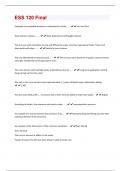
-
ESS 120 Final Exam | 219 Questions and Answers(A+ Solution guide)
- Exam (elaborations) • 21 pages • 2023
- Available in package deal
-
- $11.49
- + learn more
Examples of sustainable prehistoric civilization(s) include..... - Inca and Zuni Hopi and Zuni maize is...... - Open-pollenated and drought-tolerant The Zuni use small rock dams to slow and diffuse the water onto their agricultural fields. These rock dams work well when...... - Rainfall is more intense The Inca abandoned terraces because..... - The terraces were above the irrigation canal and were no longer needed due to the population crash The Incan terrace soils had high levels of phosp...
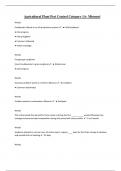
-
Agricultural Plant Pest Control Category 1A- Missouri
- Exam (elaborations) • 17 pages • 2024
-
- $9.89
- + learn more
Agricultural Plant Pest Control Category 1A- Missouri Weeds Problematic Weeds in no-till production systems ️● Field bindweed ● Johnsongrass ● Hemp dogbane ● Common milkweed ● Yellow nutsedge Weeds Forage-type sorghums (most troublesome to grain sorghum) ️● Shattercane ● Johnsongrass Weeds Soy bean problem weeds in northern Missouri ️● Cocklebur ● Common waterhemp Weeds Problem weeds in southeastern Missouri ️● Sicklepod Weeds The cr...

-
Praxis 5081 - US History Latest 2023 Graded A+
- Exam (elaborations) • 77 pages • 2023
- Available in package deal
-
- $11.99
- + learn more
Praxis 5081 - US History Latest 2023 Graded A+ Pre-Columbian Era - Groups of hunters arrive from northwest Asia and cross the land bridge Bering Strait into North America, becoming the first Americans - The Mayans, Toltecs, Aztecs, and Incas settle in Central and South America - The Adena-Hopewell, Mississippian, and Pueblo Hohokam civilizations emerge in North America - The Renaissance flourishes through Europe, leading to a revival of learning, the rise of new and powerful monarchies and th...
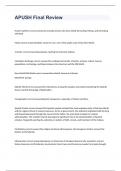
-
APUSH Final Review exam 2023 with 100% correct answers
- Exam (elaborations) • 187 pages • 2023
-
Available in package deal
-
- $19.49
- + learn more
Hunter-Gatherer A nomadic person who lives chiefly by hunting, fishing, and harvesting wild food. Maize Another name for corn, one of the staple crops of the New World. 'Contact' Europeans meeting the American Indians. Columbian Exchange The widespread transfer of plants, animals, culture, human populations, technology, and ideas between the Americas and the Old World. New World/Old World New World: American Colonies Old World: Europe Atlantic World Th...
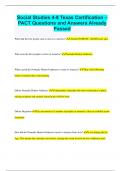
-
Social Studies 4-8 Texas Certification – PACT Questions and Answers Already Passed
- Exam (elaborations) • 13 pages • 2024
- Available in package deal
-
- $9.99
- + learn more
Social Studies 4-8 Texas Certification – PACT Questions and Answers Already Passed When did the first people start to arrive in America? Around 38,000 BC. (40,000 years ago) Who were the first people to arrive in America? Nomadic Hunter-Gatherers What caused the Nomadic Hunter-Gatherers to come to America? They were following herds of animals they were hunting Define Nomadic Hunter-Gatherers Communities of people who move from place to place, relying on plants and animals fou...
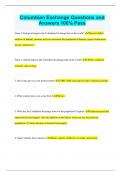
-
Columbian Exchange Questions and Answers 100% Pass
- Exam (elaborations) • 8 pages • 2023
- Available in package deal
-
- $9.99
- + learn more
Columbian Exchange Questions and Answers 100% Pass Name 5 biological impacts the Columbian Exchange had on the world? Diseases killed millions of Indians, potatoes and corn increased the population of Europe, sugar created more slavery, and horses... Name 3 cultural impacts the Columbian Exchange had on the world? Liberty, corporate structure, and ecology. 3. How long ago was corn domesticated? 5,000-7,000 years ago by native American people. 4. What country does corn come from? Mexico 5. Wh...

Do you wonder why so many students wear nice clothes, have money to spare and enjoy tons of free time? Well, they sell on Stuvia! Imagine your study notes being downloaded a dozen times for $15 each. Every. Single. Day. Discover all about earning on Stuvia


